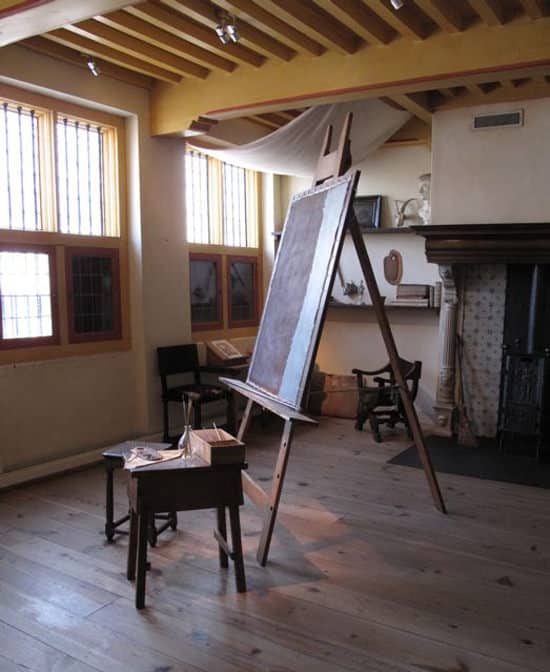Daylight for painting
| Rembrandt's studio from Will Kemp |
Keep painting...
I was beginning to notice that my output was diminishing. Two reasons - apart from non-art related issues, first of all, the room I paint in can only be used from about 1pm onwards on any day - even in summer. At this time of year, at these latitudes, the light is fading by about 3pm and it's impossible to mix colours accurately from 4pm onwards - even on a sunny day. By midwinter it will be 2pm and 3pm respectively. Secondly, the light is just less bright and it gets quite tiring to paint. So drawing is still possible and I can do that in any light, anywhere. Great, I could do with the practise. Sometimes though, it's just really nice to get in touch with paint and colours again. Try doing it under incandescent lights or halogens.... You think it's OK, but look at what you've done in daylight and it ain't pretty!A trip to Hobbycraft showed that there was a solution with various fancy clip on lamps, but at £100+ I wasn't prepared for that. Checking the wonderful Will Kemp website I learned so much and what to look for if you can't afford a purpose built studio! Some of his links may need a bit of updating as the technology moves at a very rapid rate and prices come down. Hooray! He gives a lot of detail, but here is the information you need if you want to work comfortably and get your colours right:
- Look for a lot of light (you can probably get away with less light for portraits though). You'll never match the light offered - even on the gloomiest day outside, but try to get as much as possible.
- You don't have to have pure northern light - but it does change less through the day than southern light.
- Choose LEDs rather than fluorescents. Some people are sensitive to the spiking which some describe as a flicker that's common in fluorescents (the correct name is red-blue pupillary flicker). Compact fluorescents seem to be better, but LEDs are better still for complex reasons that I won't go into. Also they are cool running, last ages and are dead cheap to run.
- Position the light correctly; I have mine just above and behind, but not so that I cast a shadow. Ideally I would have side lighting too.
- Look for a daylight bulb. Daylight covers a lot of meanings, and it is a personal thing to some extent. You probably have warm white bulbs in your home and they will kill your colour perception. Go for 4000 - 6500Kelvin temperature bulbs. The higher figure is the light from a sunny day (you'll be amazed at how cold that light looks, but eyes adapt) the lower is a bit warmer and may be closer to how the painting will be displayed in some locations (but beware of thinking that you should paint in warm light!).
- We are adapted to see in much "cooler" light than we have inside our homes when the lights are on and this cooler daylight and the greater intensity of sunlight can improve well being, maybe improve and control appetites, improve mood and restore natural sleep patterns too. Just remember to avoid using daylight bulbs and computer screens a few hours before bedtime though as it actually interferes with sleep to be exposed to it later in the day as it stimulates us; a warm cosy light to sedate is better in the evening .
- The CRI (Colour Rendition Index) is just as important and you need it to be as high as possible; at least 80 and as close to 100 as possible. This makes the colours render as accurately as possible. The CRI is about to be superseded by an even more accurate index - but that's for another time.
I opted for this bulb that I found on Amazon and it's just great; bright and accurate colour for around £10. Sorted.
 |
| Daylight LED bulb for artists and hobbyists |



Comments
Post a Comment